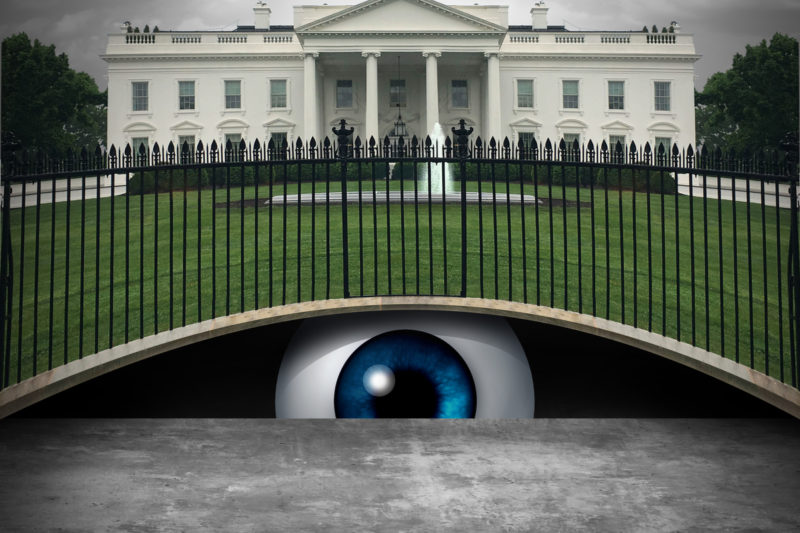The Birth of the Deep State: A History

Every presidential administration finds some degree of internal resistance. That which has confronted the Trump Administration, however, seems to be the most active and aggressive ever. From “Anonymous”, to a record number of leakers, to physically hiding documents from the President, a large and active bureaucratic resistance is at work to stymie many of the Executive branch’s goals. Everything from secret military plans to embarrassing aspects of daily life in White House has been made public.
Indeed, the deep state (as the President and his defenders brand it) has been relentless. Nor is this purely partisan. The same deep state which is dogging Trump also prevented Obama from closing the prison at Guantanamo Bay, Cuba.
But where did the American deep state come from? Has it always been there?
In fact, the evolution of the deep state (and this choice of term, “evolution” as opposed to “creation”, will be explained later) is — some might say ironically — found in a nearly 140-year old anti-corruption “reform” measure; one that was explicitly focused upon depoliticizing the civilian component of the United States government.
Let’s first describe what is called the deep state. It is the unelected part of the state that is professionalized to the point that it can be secure in its place and power regardless of political trends. It has the well-earned habit of ignoring political comings and goings, confident in its mastery of its realm. It knows the system better than any elected interloper, and it also knows its interests: survive and flourish even in the midst of upheaval.
A Fertile Soil
In the decades before the Civil War, a miniscule civil service corps was staffed via what would seem perfectly corrupt by today’s standards: the “spoils system.” Positions were doled out to individuals who had actively supported candidates or raised substantial campaign donations contributing to the victory of the newly-incumbent political party. With the defeat of the party in power, previous appointees would leave government employment and be replaced by the favored and distinguished supporters of the new administration. Needless to say, the federal bureaucracy was highly, explicitly politicized; but it was also tiny, bore few powers, and in any event almost completely overturned every four years.
With the onset of the Progressive Era came the movement to introduce “science” to many previously independent or loosely organized endeavors, and the spoils system soon came under attack. The Pendleton Civil Service Reform Act (1883) created a merit-based system of examinations and other requirements, and a salaried class of government employees.
Design flaws
In a massive, highly structured organization — in particular, one in which both the benefits of long-term service and uncommon protection from termination are present, incentives to protect the status quo loom front and center. Despite what we must assume the best intentions of the civil service reform movement were — to professionalize government bureaucracies, remove the inefficiencies associated with positions held for the duration of political cycles and (something else) — three flaws in the design of the reforms would set the stage for the next phase of evolution in the American civil service. One was structural, two were misjudgments.
The structural error was building a provision into the Pendleton Act allowing the President to increase the size of the civilian employment of government at will. While in many such accounts it was in the course of the New Deal or during the Cold War that such growth was exploited, this one was immediately evident: indeed, Grover Cleveland, the successor to Arthur, expanded the civil service from 16,000 to 27,000.
The first of two misjudgments was a failure to appreciate how the size and structure of the government itself might change. With more departments, agencies, commissions, boards, and the like, more sensitive military and intelligence functions, and a wide spate of other technical positions, the potential for activism within the civilian component rose commensurately.
And where at the time of the Act’s passage it covered approximately 12% of government employees, it now covers well over 90%. Further, a large state staffed with increasing numbers of experts necessarily competes with private interests in the employment market, and thus over time must offer compensation and benefits that rival those of firms.
The architects of the reform also failed to recognize that individuals who are hired are no less likely to have political inclinations than those awarded the same position out of sheer patronage. And where those who held positions in the spoils system were washed out of office in four years, a corps of (essentially) permanent bureaucrats facing the prospect of pensions and positions of greater influence amid zero public accountability are likely to be outwardly demure while no less political than their forebears.
So what happened?
The tremendous edifice that is the US civil bureaucracy — currently numbering somewhere around 2.85 million individuals — is, like any other huge organization, subject to both imposed and emergent orders. There are explicitly assigned executives and managers, labyrinthine organizational charts, job descriptions, pay grades, areas of responsibility, manuals of every sort, and every other standardization that informs (and hinders) the modern workplace.
But as the size of the bureaucracy has swelled it has also acquired a dissociated but consistent “consciousness”: a spontaneously-ordered, unstructured but undoubtedly focused and effective mechanism. Its major functions are to thwart political measures it collectively deems unpalatable, and to vigilantly protect the existence of the greater body within which it thrives.
No orders are issued, and there is no chain of command. It communicates by example: leaks reported in the news beget more leaks, anonymous tips spawn a rash of new tipsters. No lofty conspiracy theories are necessary; a massive army of bureaucrats in an era of free/highly affordable burner phones, file sharing services, and document scanning apps are more than sufficient to gum up the wheels of executive action.
There are no secret codes, no dead drops, and no shadowy agents meeting in parking garages in the dead of night: perhaps more dauntingly, the deep state coalesces from among a seemingly incalculable number of nondescript men and women with families and homes in the Virginia and Maryland suburbs of Washington D.C. It receives a salary every two weeks, drawn upon the United States Treasury. Its atomic elements — individuals — coach Little League, go to Zumba classes, and generally have mainstream opinions. Many, no doubt, dismiss the very notion of a deep state. Even when they send an anonymous email, shred a document intended for other eyes, or impishly pass a tip to someone with a second- or third-hand relationship in the media, most of them probably see the deep state as something larger, above and beyond themselves.
Yet they are the deep state.
(There is another, often overlooked outcome of the establishment of a fixed civil bureaucracy. Awardees of government jobs under the spoils system were usually expected to donate to, and raise funds for, their favored party’s candidates. With the elimination of what were euphemistically called “assessments” — essentially fees and donations paid by individuals for requested or desired (while virtually always temporary) appointments — the modern era of campaign finance was set in motion. In place of payment for favors, political access and influence was thereafter, and increasingly, driven by wealthy individuals, interest groups, and large corporations.)
Lingering Issues
Two larger issues loom. Much of the world around us, and perhaps most of it, is shaped not by the planning of experts, but by the unintended consequences arising of their plans. And these side effects aren’t necessarily obvious from the start; some take decades to materialize. Others arise not exclusively as byproducts of a given initiative, but in the course of interacting with other plans or their byproducts. Acknowledging that complexity should temper not only the ambitiousness of planners, but the manners and acuteness employed in watching for them.
Second, political discourse typically pivots around solutions: neat, distinct remedies which, as they are imagined, quickly and seamlessly address problems. Less frequently discussed are the wider range of imperfect solutions which present trade-offs in the short- or long-term, but may hold less surprises in the longer term. Some of the trade-offs are immediately obvious; others don’t appear for years. The corruption of the pre-Pendleton Act period seemed undesirable enough that nearly any replacement would be superior: better yet that “science” and merit should be employed in a successor system.
A bigger question is whether the deep state is, even as an unintended consequence of the Pendleton Act, a “feature” or a “bug”. Do unelected government employees play a critical role in restoring equilibrium even in a nominal democracy, or do they represent an insidious, potentially worrisome repository of accidental power?
The idea that the Federal bureaucracy was staffed by the favorite or highest-bidding individuals was remarkably distasteful to the public in the 1870s; replacing it with a merit system certainly sounded like a preferable, tidier solution. It definitely appealed to the burgeoning desire for “scientific” solutions which littered the American policy landscape between the 1880s and the end of World War I. But virtually no one could have anticipated the colossal growth in the size of the U.S. government over the subsequent 140 years and the accompanying explosion in the size of the civil service. Add to that legislative creep, whereby the President was permitted to expand the ranks of protected government employees at will, and we are faced with the present.
For a very long time, Americans have had the odd feeling that elections don’t matter nearly as much as the media hoopla surrounding them would imply. It’s true, and one reason why has everything to do with fundamental changes in the way we hire and fire within the federal bureaucracy. The emergence of the deep state is by design a buffer on democracy itself, with the cost of a less adaptable regime and growing public cynicism concerning who really is in charge.










